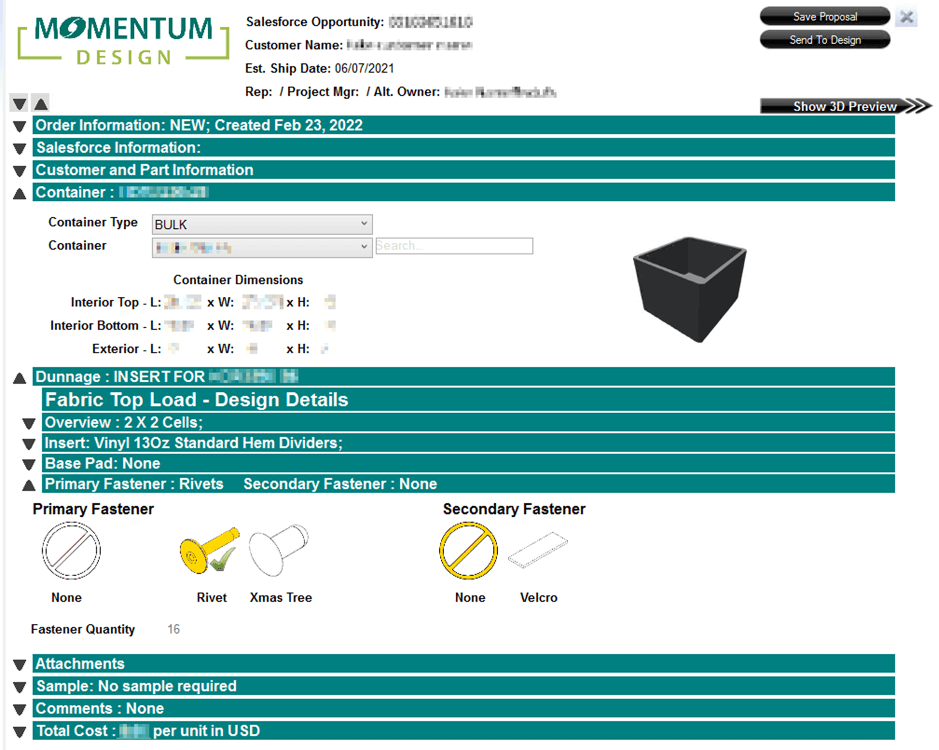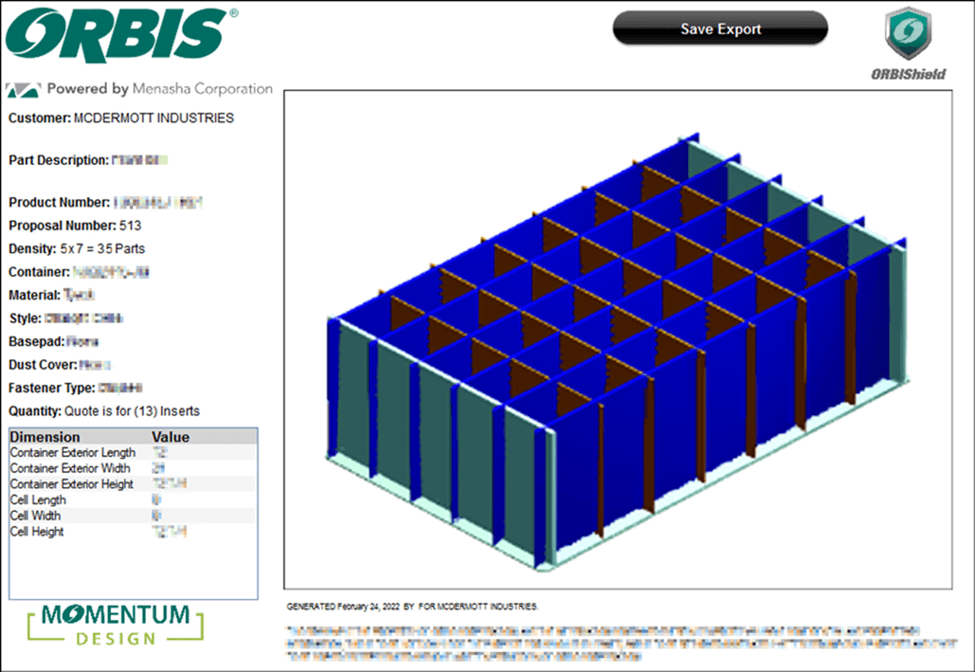Razorleaf helps ORBIS Corporation integrate DriveWorks with SQL and other enterprise platforms to create an innovative system that generates custom packaging designs, cost estimations, and manufacturing documentation on demand.
As leading companies continue to drive sustainability in their business, they scrutinize every point of their supply chains, including the packaging used to move their product. ORBIS Corporation provides reusable containers, pallets, dunnage, metal racks and bulk systems that improve the product flows all along the supply chain to reduce costs, enhance profitability and add sustainability.
ORBIS is part of Menasha Corporation, one of the oldest family-owned manufacturing companies in the United States. With a long history in the area of custom packaging, ORBIS specifically designs and manufactures dunnage to protect automotive and industrial parts in the supply chain. Due to the nature of these parts, dunnage is custom designed to precisely fit and protect the part. This custom dunnage is then integrated into handheld and bulk containers or metal solutions, to provide a turnkey pack-ready solution for ORBIS’ customers.
In 2008, ORBIS introduced a design-automation system that focused on this custom product design process. As supply chain and customer needs became more complex, ORBIS recognized that it was time to update the system. As Deb Pitman, VP of Process Improvement for ORBIS, notes, “We needed to do something different. We knew this particular area of our business was a place where we could grow, but the systems we were using weren’t talking to each other.”
An initial false start
ORBIS began the internal project to upgrade its design automation system in 2017, and by early 2018 had settled on DriveWorks, a design-automation software tool that automates SOLIDWORKS, the leading CAD 3D design package from Dassault Systèmes. ORBIS worked closely with a DriveWorks reseller to set up the new system, and they were just about to take the system live when they realized they had a huge problem. The system was not ready for prime time.
Their brand-new design automation platform wasn’t going to do what ORBIS needed it to do, and moreover, it wasn’t creating a good user experience internally or for customers. So ORBIS made the difficult decision to pull the plug on their multi-year effort and start over. “It was painful, but it was absolutely the right thing to do,” Pitman says. “And as tough a decision as that was, I think it has helped us in other areas of our business to ask some different questions as we’re working on projects.”
Pitman acknowledges that the fault for the false start lay on both sides of the vendor-customer relationship. The ORBIS team, for its part, hadn’t really understood their own design requirements and what the company needed out of the solution until they were hip-deep into it. Once they did, they discovered they wanted to work with a reseller who would empower them to solve their problems and show them how to fully optimize the system on their own.
Vince Riha, ORBIS Designer and Integrations Specialist, further explains the problem: The initial project approach “used what DriveWorks can self-contain and generate. That’s a good solution for some certain-size companies. We’re an enterprise, and we needed to scale up and interface with other applications.”
Riha had done his own research and found a blog post claiming DriveWorks could work with an SQL database. “They said we couldn’t do it,” he says, speaking of ORBIS’ initial partners. “I knew we either had the wrong product or the wrong people.”
A change in partner brings a solution
In late 2019, ORBIS searched for another partner with DriveWorks experience to help them identify what they could do differently. That’s when they connected with Razorleaf, a vendor-agnostic PLM services provider, for insight and input on what had been developed to date, as well as where they could help ORBIS make some future changes. Pitman says, “Razorleaf helped us reframe our expectations—and absolutely has supported us to get where we are.”
First, Razorleaf worked with ORBIS to better understand their project and user needs. Then Razorleaf built ORBIS an interface that integrates with DriveWorks, SQL, and Salesforce with ORBIS’ project management and costing application via web services. At every step along the way, Razorleaf taught the ORBIS team to be self-sufficient. “We really have flipped the switch, where they were originally doing and showing to just really coaching and mentoring our team now,” Pitman said.
Razorleaf’s own Business Process Sherpa, Paul Gimbel—author of that DriveWorks-SQL blog post that initially caught Riha’s eye—agrees: “We like to help customers by giving them a foundation. To make sure that you’re able to maintain the care and feeding of your own system and continue to grow it. That’s really what the projects we did for ORBIS were, a foundation.”
Razorleaf’s own Business Process Sherpa, Paul Gimbel—author of that DriveWorks-SQL blog post that initially caught Riha’s eye—agrees: “We like to help customers by giving them a foundation. To make sure that you’re able to maintain the care and feeding of your own system and continue to grow it. That’s really what the projects we did for ORBIS were, a foundation.”
Integrate internally, connect externally
The DriveWorks system that exists now at ORBIS allows their sales team to work with customers on custom design solutions and—in real-time—generate a 3D model and a cost estimate for exactly what the customer needs. The point of the system, after all, Pitman explained, was to generate something that makes the customer say, “Yes, I want you to manufacture that as quickly as possible.” The system automates all the behind-the-scenes work that only engineers and estimators know how to do and puts the information in the hands of the sales team immediately, resulting in faster response to customers.
In addition, when a proposal is initiated through Salesforce, DriveWorks creates a new set of design files and generates the BOM (bill of materials) and manufacturing process routings required to develop the product. DriveWorks builds and stores the BOM and routing information in a SQL database, also generating SOLIDWORKS models and drawings, storing them in ORBIS’ EPDM system and communicating with other relevant enterprise software platforms, including SAP.
The DriveWorks system currently contains two ORBIS product lines, each with tens of thousands of different products, because customers have a large number of features, sizes, materials, and construction options available. “When we started the first project,” Riha says, “we counted 26,000 iterations of a single product. And since then, we’ve expanded on that.”
Compressing the timeline from product design to the sale
ORBIS realized benefits from the enhanced DriveWorks system immediately. Pitman says, “We’re still learning, but I would say that things that could have taken anywhere from two to five days to get back into a customer’s hands, have taken a day or less now.” Customer responsiveness is a key goal for ORBIS, but they’re also seeing dramatic improvements in internal efficiency. Because the sales team can generate preliminary designs, cost estimates, BOM, and Routings, that means the design, estimation, and manufacturing teams have something to work with, instead of starting from scratch. “It’s compressing the overall timeline,” says Riha.
The system contributes to more standardization of process and data than they’ve ever had before, because the information that was once handed over manually from team to team is being automated via systems that couldn’t communicate in the past but are now connected. That, in turn, increases the accuracy and quality of the enterprise’s data.
Enabling product-line growth
ORBIS is in the process of adding a third product line to DriveWorks and has a multi-year plan to continue bringing in more product lines to keep the system growing. Continuous improvement is part of the fabric of ORBIS, especially evaluating what systems and processes they have in place and continuing to expand the most efficient and effective use of them to drive business. “Because of where Razorleaf was able to get us, now we can continue to grow,” says Pitman. “If all of this continues to evolve, the opportunities are going to be endless.”

Image 1 (UXSample) – This dynamic graphical user interface, launched from Salesforce, employs 2D and 3D images to guide users through the design of custom container dunnage.

Image 2 (3DPreview) – Leveraging the DriveWorks 3DPreview technology to provide instant 3D interactive views and a downloadable custom drawing
